

TRAVELOGUES FROM


jumeirah.com/MarsaAlArab


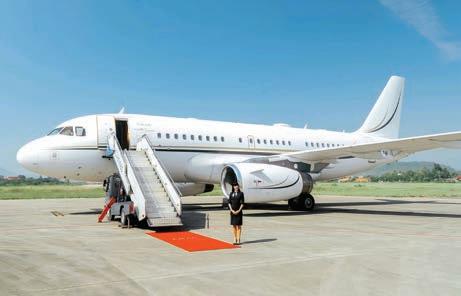

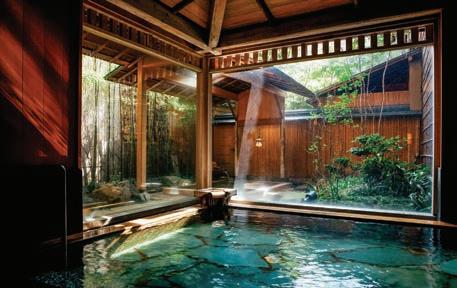
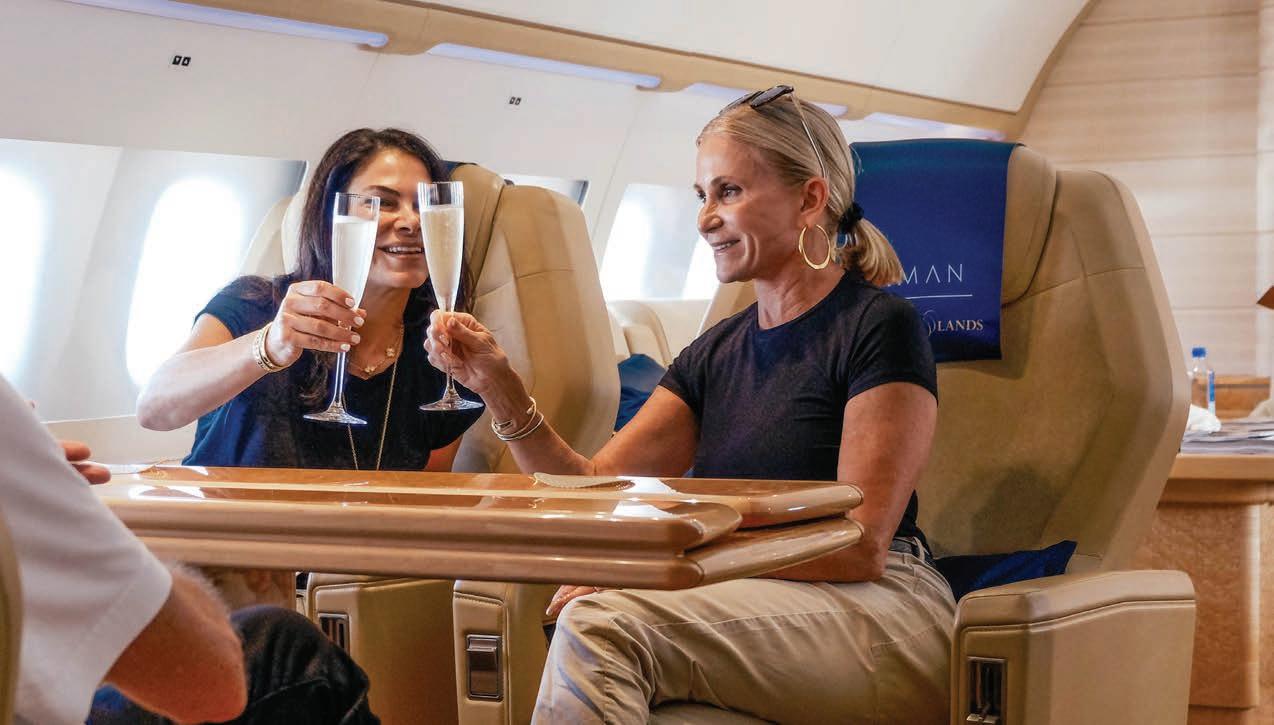

EDITOR’S NOTE
DUNCAN FORGAN
Ultra-luxe can be hard to define. In our view it is about turning dreams of luxury, comfort, and opulence into reality. And an unwavering commitment to the ultra-luxe ethos is at the very heart of the Remote Lands brand.
By leveraging our expertise, vast network of connections, and deep knowledge, we can help to craft truly one-of-a-kind, unforgettable travel experiences. Thankfully we’ve got lots of support in doing so from friends who share our vision around Asia.
From Michelin-approved culinary journeys in hubs such as Bangkok, Tokyo, and Singapore to exclusive access experiences and some of the world’s most fantastical suites, Asia is brimming with opportunities to push the envelope out in the most exquisite style.
In this magazine we’ve curated some of our favorite ultra-luxe experiences in Asia.
It’s not an exhaustive guide — there’s too much for us to cover every wow experience in Asia comprehensively. We hope, though, that you’ll start dreaming new dreams we can help make reality.

Remote Lands Co-Founder, CEO
Remote Lands Co-Founder, COO
Editor-In-Chief Designer Contributors
Director of Product
Digital Marketing VP of Business Strategy
Marketing Specialist & Content Creator
Head Offices Asia Offices
Catherine Heald
Jay Tindall
Duncan Forgan
Vatanya Bongkotkarn
Duncan Forgan, Travelogues Staff
Trinity Nguyen
Liam Vickers
Melisa Novick
Maneenart Srisakulpanich
Remote Lands, Inc., 120 East 56th Street, Suite 1600 PH, New York, NY 10022 USA +1 (212) 518-1618
Remote Lands (Thailand) Co., Ltd., 9/F Mahatun Plaza, 888/94-95 Ploenchit Road, Lumpini, Pathumwan, Bangkok 10330 Thailand +66 2651-5401




WHAT’S ON OUR RADAR
With travel in full swing, Asia is asserting its reputation as one of the most exciting destinations on the planet
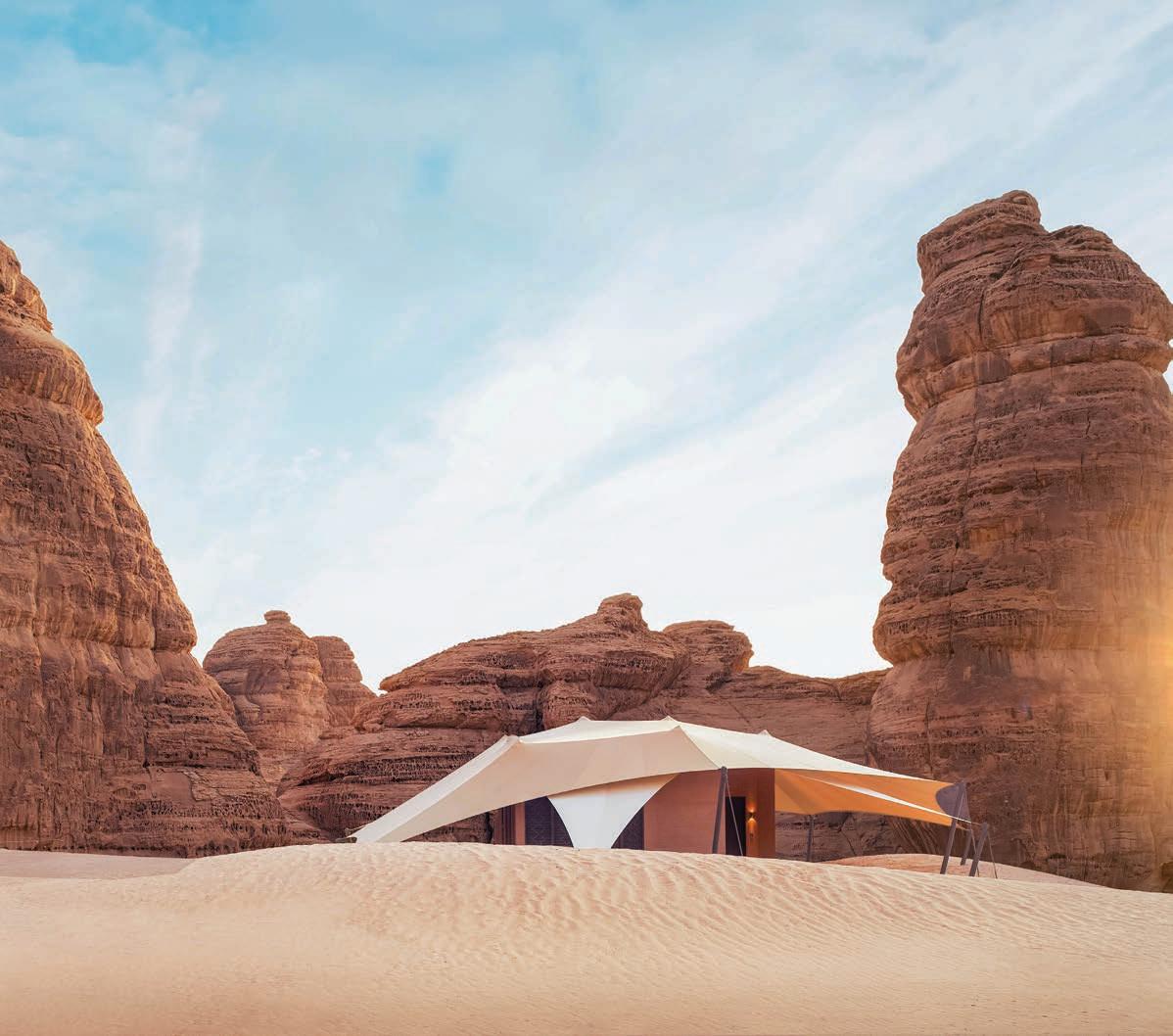
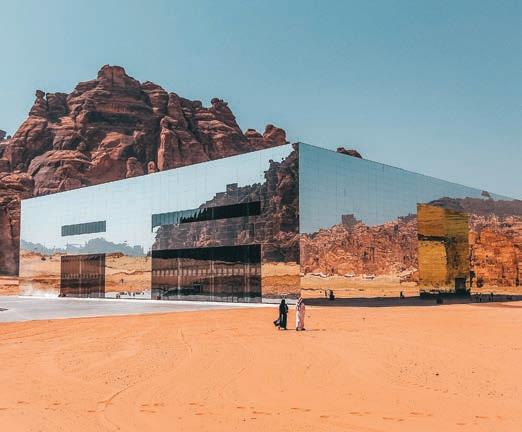

DESTINATION IN DEMAND: AL ULA, SAUDI ARABIA
Located deep in the desert in the northwest of Saudi Arabia, Al Ula is one of the country’s most beguiling destinations and a future hotspot for travelers.
Rich in historic and geographical significance — an ancient city that once sat at the crossroads of the Silk Road and the Incense Route — it is home to Saudi Arabia’s first UNESCO World Heritage Site.
The draw to this remote destination is its remarkable natural rock formations and canyons, extensive and varied pre-Arabic rock art, and immaculately preserved tombs built more than 2,000 years ago by the Nabataeans.
In 2019, Crown Prince Mohammed bin Salman launched the Al Ula vision, which features a nature reserve called Sharaan, as well as the establishment of the Global Fund for the protection and revitalization of the Arabian Leopard.
The draw to Al Ula is its remarkable natural rock formations and canyons, extensive and varied pre-Arabic rock art, and immaculately preserved tombs built more than 2,000 years ago by the Nabataeans.
At Hegra, once the southern capital of the Nabataean kingdom, visitors can explore more than 100 well-preserved monumental tombs, most with elaborate facades carved from rock formations scattered around the desert.
Another key site is Elephant Rock. Set in golden desert sands and climbing into the blue Arabian skies, the rock (also known as Jabal Alfil) is one of Al Ula’s most impressive geological marvels.
Unlike the ornate, hand-carved facades of nearby Hegra’s Nabataean tombs, the “trunk” and “body” of this monolithic red sandstone beast were shaped by natural forces — millions of years of wind and water erosion.
Properties such as Habitas Al Ula¬—an upscale adults-only hotel that brings luxury living to Al Ula in an eco-friendly manner— and Banyan Tree Al Ula, a desert retreat inspired by the natural surroundings of the Ashar Valley are burnishing accommodation options. And with Aman expanding here in the coming years, Ul Ula is a destination on the up.

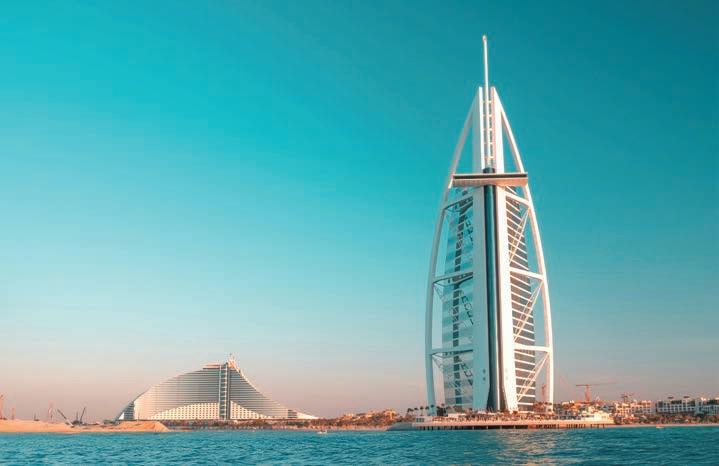
NEXT-LEVEL LUXURY

Asia, meanwhile, is also entering a new era of ultra-luxury. In Taiwan, the upcoming Capella Taipei is drawing buzz for its ‘modern mansion’ concept. Designed by André Fu, the 86-key hotel combines poetic minimalism with cosmopolitan flair. Dining promises to be a major draw: from artisanal French-inspired fare at The Grill to a sleek Japanese Omakase and Cantonese spot with Taiwanese accents.
In Thailand, Aman Nai Lert is bringing the brand’s trademark serenity to central Bangkok. Nestled in Nai Lert Park, the property will combine lush greenery with Aman’s distinctive design language—an urban oasis promising calm amid the capital’s chaos.
Poised near the iconic Burj, Marsa Al Arab bills itself as a “playground for horizon seekers,” with 390 rooms, suites, and penthouses framed by sweeping 11-metre floor-to-ceiling windows
The Dubai skyline is no stranger to spectacle, but Marsa Al Arab is raising the bar once again. Poised near the iconic Burj Al Arab, the new Jumeirah flagship bills itself as a “playground for horizon seekers,” with 390 rooms, suites, and penthouses framed by sweeping 11-metre floor-to-ceiling windows. Highlights include four pools (from serene spa to family-friendly), a three-storey wellness sanctuary, and a collection of standout restaurants. A superyacht marina and nine oceanfront villas add to the extravagance.
Elsewhere in Dubai, Atlantis The Royal continues to make waves. With 795 rooms and suites, 17 dining venues, and a sky-high infinity pool bridging two towers, it delivers the kind of maximalism the emirate is known for.
Further north, Six Senses Kyoto debuted in spring 2024, offering a thoughtful, culturally steeped retreat in Japan’s former imperial capital. Inspired by the Heian period and “Miyabi” (courtly elegance), the hotel weaves historical references into its architecture, wellness offerings, and hyper-seasonal cuisine, with suites that open onto private courtyards or frame peaceful garden views.
And in Saudi Arabia, the future is unfolding in real time. Nujuma, A Ritz-Carlton Reserve is set to open soon as part of the Red Sea’s monumental eco-tourism initiative. Accessed by seaplane or boat, the resort’s overwater and beachfront villas offer telescopes for stargazing and front-row seats to one of the world’s most untouched marine environments. ...
TAKING FLIGHT
Asia offers endless visual manna, with incredible landscapes ranging from karst-studded seascapes to snow-capped mountain ranges.
Experiencing these stunning vistas from a helicopter provides a unique and awe-inspiring perspective that often trumps other modes of transportation due to the sheer mobility that a helicopter can offer.
Helicopter rides are often associated with luxury and exclusivity. They provide an opportunity to indulge in a premium travel experience, offering comfort, privacy, and personalized service. They also offer the flexibility to reach remote and inaccessible areas that are often untouched by traditional transportation methods. This means travelers can discover secluded gems, and off-the-beaten-path destinations.
Several fresh helicopter tours around the region are taking things up a notch.
In Indonesia, bespoke itineraries can be arranged around Bali, Java and Lombok that promise adventure and exploration. Tours can be focused on a range of incredible locations including volcanoes like Mounts Batur, Rinjani and Ajen and tropical seascapes like Alas Purwo National Park.
Tours utilize a state-of-the-art helicopter, the brand-new Robinson R66. With a capacity to accommodate up to four passengers, this remarkable aircraft is equipped with cutting-edge features, including Garmin glass technology, a Rolls Royce engine, air conditioning, and Bose headphones, ensuring the utmost safety and a luxurious experience.
In Japan, helicopter tours can be arranged in an array of incredible locations. Take in Tokyo’s spectacular cityscape by night, cruise over Hokkaido’s stunning Lake Toya, or observe the patchwork of sea and land that characterize Okinawa, the country’s tropical southern frontier.


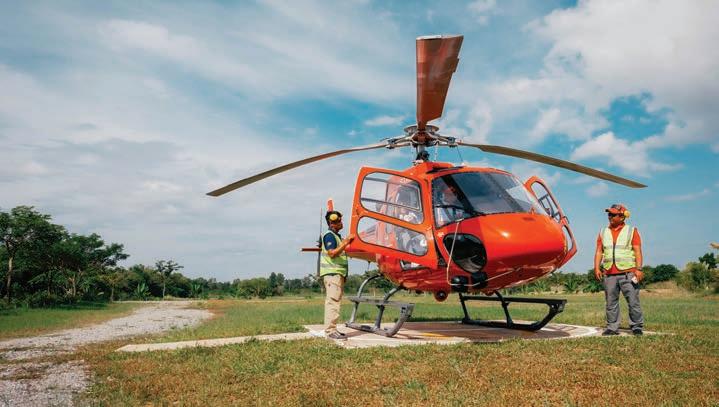


ACCESS ALL AREAS
Authentic ultra-luxe is characterized by transformative, exclusive experiences that leave an indelible impact
When contemplating opulence, the mind tends to conjure images of extravagant mega yachts, private transfers, and indulgent traditions.
However, there’s a view that true luxury lies in the exclusive access to the world’s most transcendental travel experiences.
From convening with a living goddess in the Kathmandu Valley to witnessing sunrise at Borobudur in Indonesia with an expert in archeology, Asia lends itself brilliantly to an array of adventures that would be all but impossible to arrange independently.
Whether it involves partaking in a gourmet lunch on the Great Wall, or learning about Geisha culture, these extraordinary encounters all share a common thread: they are truly once-in-a-lifetime opportunities.
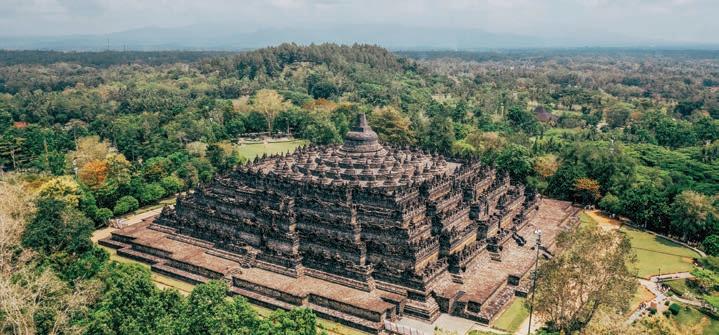

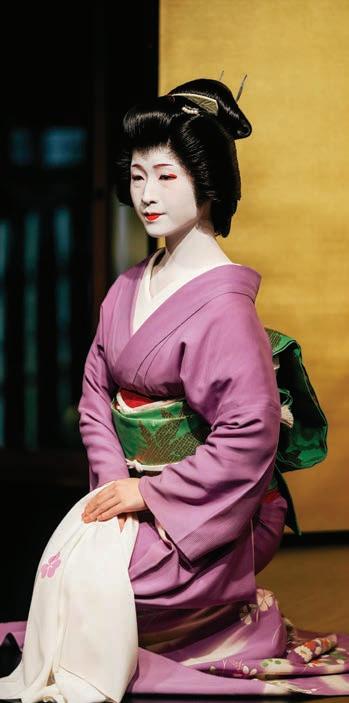
SALUTE THE SUN AT BOROBUDUR
Start your day with an unforgettable perspective on Borobudur, the world’s largest Buddhist temple located in Indonesia.
Soak in the relic at dawn when the early light of the day imbues the temple and its magnificent carvings with a magical aura.
Named ‘Peaceful Soul’ due to its serene location in the heart of Central Java, Amanjiwo boasts stunning views of the UNESCO World Heritage Site.
As the site reopens its doors, it remains free from overwhelming crowds, providing a unique chance to immerse oneself in the pure essence of this spiritual setting. And the resort’s incredible access to this exceptional experience makes it a truly special place to stay.
As the sun rises over the horizon, you’ll witness the magical sight of the temple immersed in golden hues.
DATE WITH A GEISHA
Geishas embody the spirit of ancient Japan and Japanese beauty.
They study the ancient arts of flower arrangement, music, dance, tea ceremony, and more to entertain their patrons.
In the enchanting city of Kyoto, indulge in an exclusive Geisha dinner experience.
You’ll have the rare opportunity to interact with Geishas in an intimate setting, enjoying a meticulously prepared traditional multicourse meal known as Kaiseki.
Throughout the evening, the Geishas will entertain you with their grace, wit, and captivating performances, creating an ambiance of elegance and charm.
To begin dinner, your hostess will pour you a glass of beer, but she won’t pour one for herself. According to Japanese customs, you are to pour her beer for her, and she won’t move to take a sip until you toast her and begin drinking.
During your meal, she’ll lead the conversation and might tell a few anecdotes to keep the flow going. After dinner entertainment often includes a musical performance and traditional Japanese drinking games.
AN ANGKOR AFFAIR
Like the Eiffel Tower and Paris and the Statue of Liberty and New York, the temples at Angkor are synonymous with Cambodia.
Immerse yourself in the crowning relics of the once-mighty Khmer Empire with a private temple dinner experience.
Explore the magnificent Angkor Wat temple complex during the day, and as the sun sets, indulge in a gourmet dinner set up exclusively for you within the temple grounds.
Surrounded by the awe-inspiring architecture and mystical atmosphere, savor a delectable meal while enjoying the tranquility and grandeur of one of the world’s most iconic UNESCO World Heritage Sites.
GREAT WALL FOR GOURMANDS
There’s no disputing the status of the Great Wall of China as one of the world’s great sights. Nothing beats a first-hand look at one of history’s most incredible engineering feats.
And one of the best ways to experience the structure is to indulge in an unforgettable culinary journey on the wall itself.
Enjoy a gourmet Chinese lunch prepared by master chefs, served in an exquisite setup with panoramic views of the landscapes surrounding the structure.
This exclusive dining experience allows you to savor delectable Chinese cuisine while basking in the historical grandeur and natural beauty of one of the world’s most iconic landmarks.
CHENGDU’S BEAR NECESSITIES
No animal more symbolizes China than the panda.
And in recent times the Chinese government has been expending more effort to protect its endangered national emblem. Sanctuaries have been established to nurture the animals and guests can do their bit to assist in conservation efforts.
Visitors can spend a day as a volunteer, feeding fruit and bamboo to the bears, preparing their baths, and taking part in their daily weigh-in
This hands-on encounter provides a unique opportunity to contribute to the preservation of these endangered animals and create lasting memories.
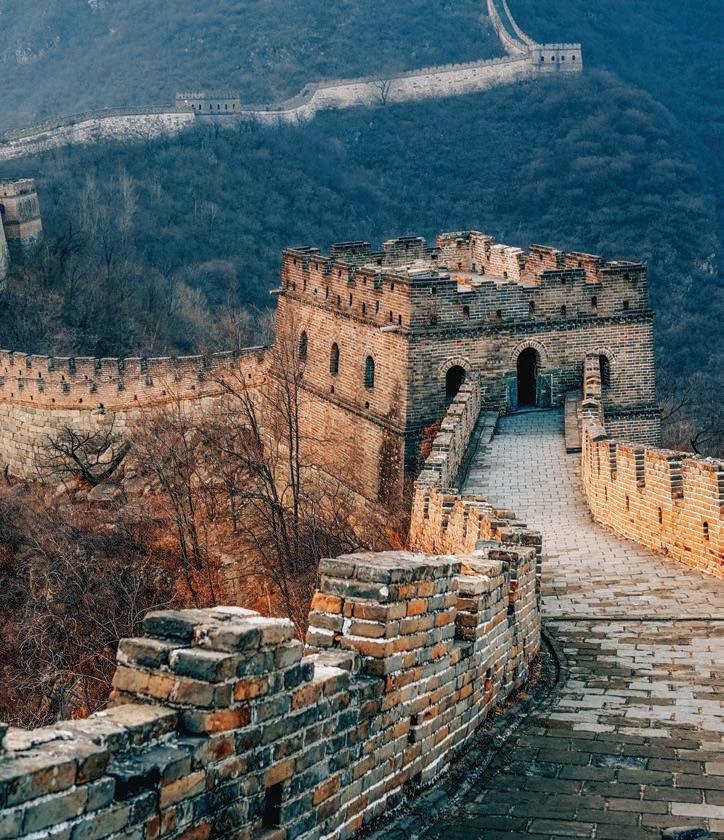
The Great Wall is one of the world’s great sights, and nothing beats a first-hand look at one of history’s most incredible engineering feat
CONVENE WITH A GODDESS IN KATHMANDU VALLEY
Patan is home to Kumari, one of Nepal’s living child goddesses. These young girls are worshipped as part of a millennia-old aspect of local Hindu and Buddhist culture. The Kumari is paraded through Patan each September, during the Indra Jatra festival, a huge, photogenic event that unfolds across the valley.
Considered to be the embodiment of the divine female energy, the Kumari is a young girl chosen through an elaborate selection process.
Guests can receive her blessings through an audience and witness her presence during a sacred ceremony. This encounter offers a rare glimpse into the rich religious and cultural heritage of Nepal. ...
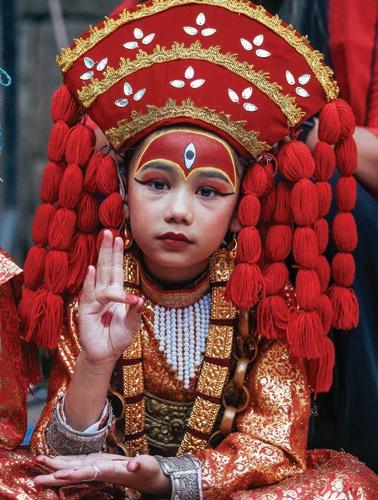
UNKNOWN TREASURES

With accommodation options ranging from tented camps to plush hotels, there’s plenty to love about heading off-radar

Venture into the heart of Mongolia’s vast and untouched landscapes by embracing the luxury of a private tented camp
Some Asian destinations — The Maldives and Dubai spring immediately to mind — scream ultra-luxe. Others are less obvious quarry for upscale experiences. And perhaps it is this element of the unknown that makes luxury travel in destinations such as Nepal, Ladakh in northern India, Mongolia, and Azerbaijan so special.
Sumptuous steppes
Rugged Mongolia is an adventure destination where travelers can experience vast, untouched landscapes and learn about the nomadic culture.
Venture into the heart of its vast and untouched landscapes by embracing the luxury of a private tented camp.
Set up anywhere in remote regions, these exclusive camps come with a dedicated crew, ensuring an unparalleled level of service and comfort. Immerse yourself in the breathtaking scenery, surrounded by the tranquility of nature, while enjoying the finest amenities and personalized attention.
Whether it’s watching the sunrise over the steppes or encountering the elusive Mongolian wildlife, this remarkable experience offers a unique blend of opulence and raw wilderness.

Luxury in the “Land of Fire”
Known as the “Land of Fire”, Azerbaijan has a wealth of experiences and sights to ignite the passions of any traveler.
Discover the opulent side of Azerbaijan in its capital city, Baku, where big hospitality names such as Four Seasons Hotel Baku enhance the city’s high-end appeal.
Experience the ultimate in comfort and sophistication while exploring the city’s rich history and modern charm.
To add an extra touch of extravagance, engage a premium vehicle for your transportation needs, ensuring every journey is as luxurious as your destination.
For culinary connoisseurs, sample the finest delicacy with a caviar-tasting experience, savoring the flavors of this exquisite treat. Azerbaijan’s capital promises a fusion of culture, luxury, and indulgence. There’s a wealth of cultural gems to discover in Baku itself. Chief among the city’s attractions is its old city, which is still a vibrant, living quarter. Its narrow cobblestoned alleyways, historic caravanserais, hammams, mosques, and hidden courtyards tell the story of Baku’s evolution through the centuries.




India’s northern star
It’s easy to understand why Ladakh is often known as India’s final frontier.
Almost completely cut off from the outside world between November and May due to freezing winter conditions, and only reachable during the summer months via the highest mountain passes in the world, it’s a magical and mystical destination unlike any other.
Ladakh is blessed with some unforgettable accommodation options amid its otherworldly beauty. The Ultimate Travelling Camp properties throughout India are synonymous with being the ne plus ultra of glamping, and the facilities at its two Ladakh camps – Chamba Camp Diskit and Chamba Camp Thiksey — could surpass many a 5-star hotel.
Nothing exudes luxury more than having all things luxe in a remote destination. Heated triple-layered canvas tents have gleaming hardwood floors, Kashmiri carpets, elegant colonial furniture, a hot shower, Ayurveda-inspired toiletries, a complimentary refreshments bar, ample plug sockets, loungers, bejeweled chandeliers, and 24-hour butler service (who can say no to coffee on call?).
The spacious tents also open out to some of the most beautiful scenery on the planet.
Himalayan Heights in Mustang
Stretching north from the Annapurna range towards Tibet, Mustang is one of Nepal’s most unique regions.
Indeed, with its high-altitude desert landscapes and procession of Buddhist chortens (stupas), you could be forgiven for thinking you’d passed by the border crossing into Nepal’s northern neighbor without realizing it.
The main gateway to this magical corner of the Himalayas is Jomson, which is cut off in two halves by the Kali Gandaki: the deepest gorge in the world. This area is now home to Shinta Mani Mustang, the Nepal debut for Thailand-based American hotel designer Bill Bensley.
Mustang is characterized by desert landscapes punctuated by towering peaks like Mount Nilgiri and a procession of Buddhist chortens (stupas).
Interiors at the new property will incorporate warm-colored fabrics and materials to reflect the rich tones of the surrounding landscape, which can be viewed from every window of the Lodge. Huge fire pits on the outdoor terrace will allow guests to admire millions of stars in the night sky in warmth as the temperatures dip.
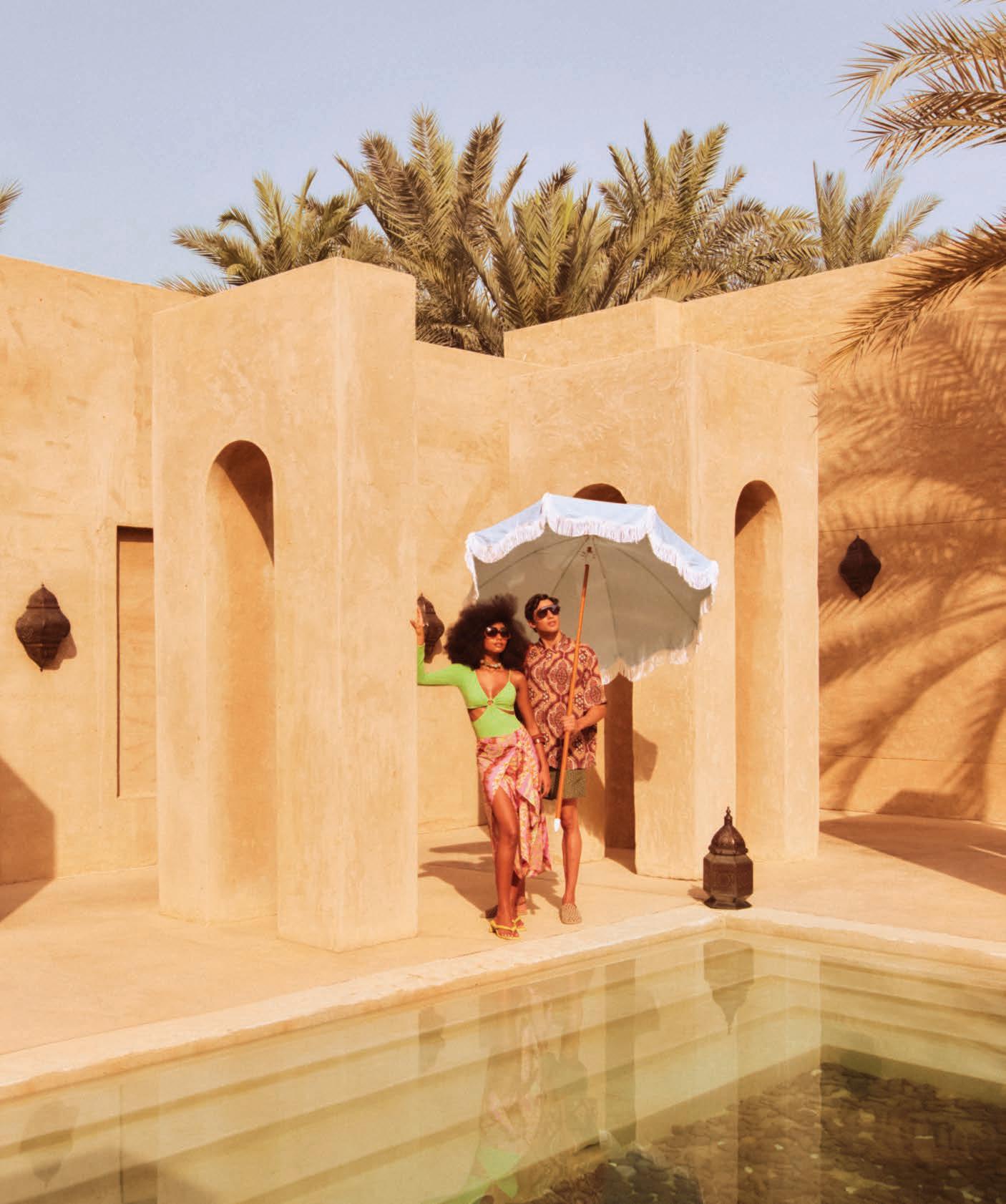


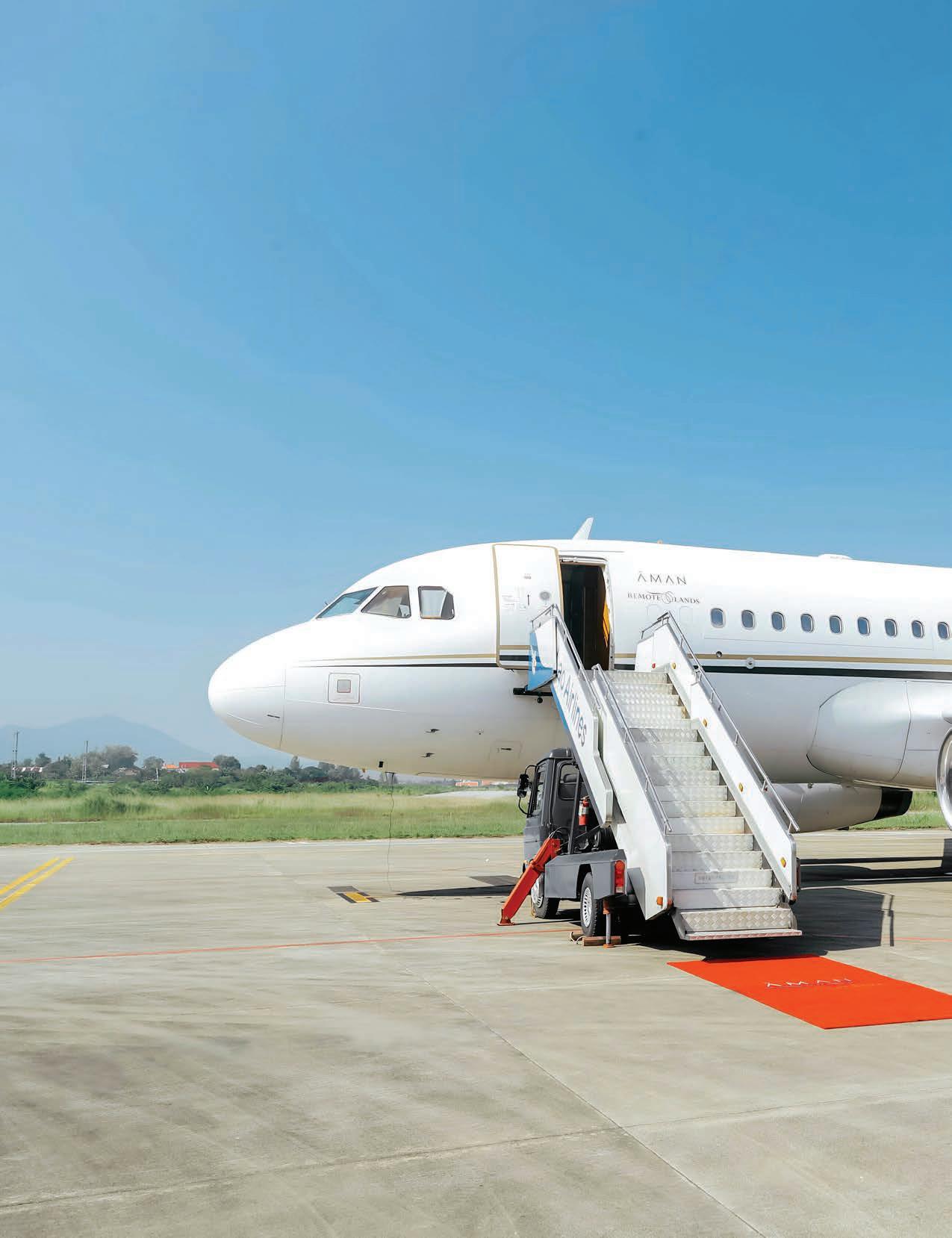
FLIGHT of YOUR LIFE
With curated experiences, private transfers on a state-of-the-art jet, and accommodation at Aman resorts, Aman Jet Expeditions represent the pinnacle of travel
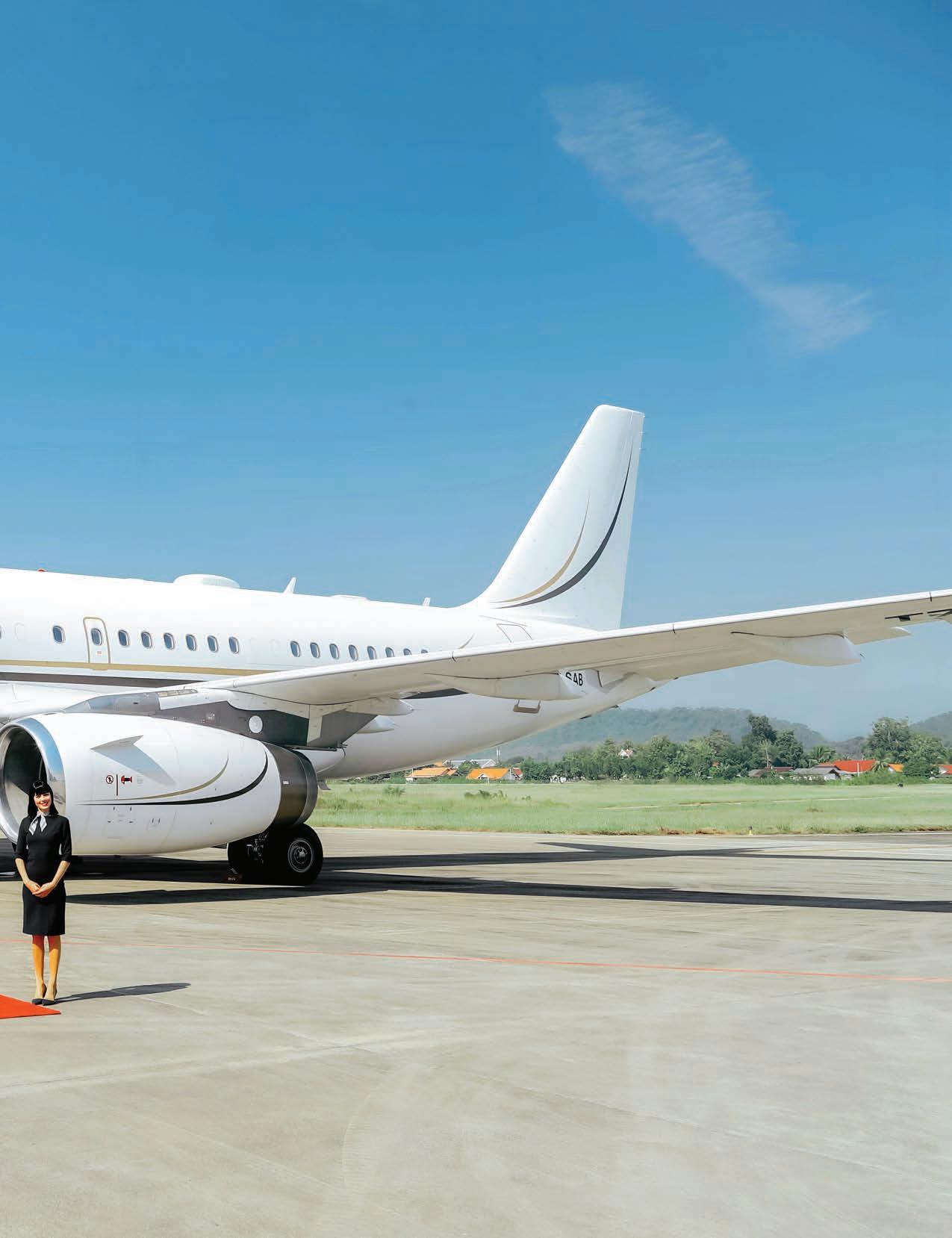


SETTING THE SCENE
Grand tours don’t come more memorable than Aman Jet Expeditions. Utilizing the ultimate in state-of-the-art private jet transportation — like the Airbus ACJ319 — these epic adventures take in some of the globe’s most spectacular destinations and experiences.
Aman Jet Expeditions are a special collaboration between Remote Lands and Aman.
Limited to up to 18 guests, you will travel in the absolute pinnacle of style and enjoy touring and transfers with your own private car, driver, and guide.
In addition to sampling the very best that Asia and beyond has to offer, guests stay exclusively at incredible Aman properties that encompass everything from private-island resorts to retreats hidden away in secret gardens amid ancient forests. Along the way, you’ll experience cultures shaped by centuries of tradition, lands blessed with breathtaking natural beauty, and cities pulsing with vibrant energy.
“We’re workaholics, so we never got to travel that much,” said Joni from New York. “And when we did travel, it was such a big deal, with getting things arranged and whatever. With the Aman Jet Expeditions it is like a fairy godmother came down and said, ‘okay, I’m going to take care of every detail and I’m going to do it not just first class, but way above first class’.
“There are so many things that are special about these trips. For a start, it’s just the best way to experience so many special countries and cultures within a relatively short period of time. Secondly, there’s the comradeship. We expected to meet some interesting people. But we ended up making lifelong friends.”
TAILORED TO YOU
Imagine bespoke travel experiences that span multiple continents — from Kyoto to Venice, from Vietnam to the Maldives. These journeys are thoughtfully designed for travelers who value access, ease, and authenticity — all with the serene and secluded touch Aman is known for.
Whether it’s helicopter rides over Bali’s Mount Batur, stargazing on a private island in the Philippines, or walking through ancient ruins in Greece, these curated special experiences — handpicked by the experts at Remote Lands and Aman — are at the heart of every expedition. Each moment is crafted to offer rare insight, intimate cultural connection, and a chance to reflect and recharge.
Each journey blends cultural immersion, gastronomic highlights, and Aman’s signature tranquility. Among the latest itineraries is Cities to Tropics: Kyoto to Bali, which takes in Japan, China, the Philippines and Indonesia, with everything from calligraphy workshops in Shanghai to helicopter rides and healing rituals in Ubud. The experience is a deep dive into the urban pulse of East Asia and the serene beauty of Southeast Asia’s islands.
Equally dazzling is Around the World in Three Continents, a 20-night odyssey that starts in Japan and spans Southeast Asia, the Indian Ocean, the Middle East, and Europe. Guests stay in Aman properties and curated partner hotels, taking in the temples of Borobudur, the medina of Marrakech, and the canals of Venice.
The wonders of the Middle Kingdom are the focus for China’s UNESCO Treasures, a 12-night expedition that showcases five UNESCO World Heritage Sites. Guests will stay in four Aman properties—each deeply connected to its surroundings—and experience marvels including the Great Wall and the misty peaks of Zhangjiajie.
For guests seeking a deep dive into regional beauty and history, Discover Southeast Asia now runs twice a year and includes an optional Bhutan extension, where you can hike to the cliffside Tiger’s Nest Monastery, take part in a traditional astrology reading, and unwind with hot stone baths amid pine forests.
“The contrast between destinations is just absolutely spectacular,” said Elizabeth from Ohio. “One day we were immersing deeply at Angkor Wat in Cambodia, the next we were giving alms to monks at dawn in Luang Prabang. It’s such a special experience.”
Guests will meet fascinating people along the way, from religious scholars to master artisans. And while the camaraderie of the group creates a social dimension, all touring is private, with a dedicated car, driver and guide per couple. The intimacy of each interaction, the access granted, and the attention to detail combine to create a profound sense of place.


MAGIC IN THE AIR
The jet is a magnificent custom-outfitted ACJ 319 — or similar. While normally configured with 150 seats, this version has just 19, offering exceptional space and comfort. Every aspect of the jet interior is designed for connection and relaxation, with leather armchairs, open lounges, and bespoke detailing throughout.
Even if you usually fly private, this is in another league entirely. The cabin is arranged into two distinct lounges, creating a relaxed, social atmosphere that makes even long-haul transfers something to look forward to. Conversations flow, friendships are forged, and anticipation builds as the next destination approaches.
“We fly by private jet a lot, but this one is just outrageous,” said Ken from South Carolina, who has now done three Aman Jet Expeditions. “There’s so much space to kick back and relax and the crew is so fantastic. They treat you like royalty.”
Champagne and premium wines flow throughout. The flights are often likened to “cocktail parties in the sky,” with elegant meals served on fine china and conversations flowing as freely as the Dom Pérignon. The culinary offerings reflect the upcoming destinations — sushi en route to Japan, tropical fruits before landing in the Philippines, mezze ahead of arrival in the Middle East.
“It’s like you are not on a plane,” said Christina from Hawaii. “There’s a bedroom and beautiful bathroom. The flight attendants are wonderful. They know your name. They know what drink you’re waiting for. And they’re interested in your experience. So rather than fear travel between destinations, you anticipate it with excitement.”
Three flight attendants, two pilots and an onboard engineer ensure service and safety are exceptional throughout. The journeys are stress-free, luxurious, and uplifting — quite literally.




REMARKABLE RESORTS
Some of the brightest stars of each Aman Jet Expedition are, of course, the Amans themselves. With each journey covering multiple properties — up to eight in some cases — guests experience a stunning diversity of settings and styles. Each property offers a moment to pause, a new perspective to take in, and a heightened awareness of the beauty around you.
Stay at Amanpulo in the Sulu Sea, on a forested clifftop in Bhutan, on the beach in Sri Lanka, or above the rooftops of Tokyo. Some itineraries, like The Grandest Tour, take in as many as seven countries, from the Silk Road majesty of Samarkand to the sunlit serenity of Amanzoe in Greece. The variety is astonishing, and yet each destination feels unmistakably Aman — refined, quiet, restorative.
Every Aman is designed to reflect its location, from the architecture to the cuisine to the rituals. As Stephanie from California puts it: “Each Aman reflects that culture.
They’re reflecting Greece. They’re reflecting Bali. They’re reflecting beautiful places all over the world. And they don’t do it in a way that you walk into an Aman and know exactly where everything is because it’s not cookie cutter. It’s different.”
Even the few non-Aman additions — such as JOALI in the Maldives and Dubai’s Burj Al Arab — are chosen with exacting care. The same standards of service, intimacy, and immersion apply, ensuring a consistently exceptional journey.
Wherever you go, the Aman ethos of calm, privacy and intuitive service ensures an experience that is effortless and extraordinary. Your every need is anticipated. Your preferences remembered. Your space sacred.
To see the world like this — curated, connected, and deeply personal — is the ultimate luxury. Each Aman Jet Expedition is a transformative experience that lingers long after your final landing.
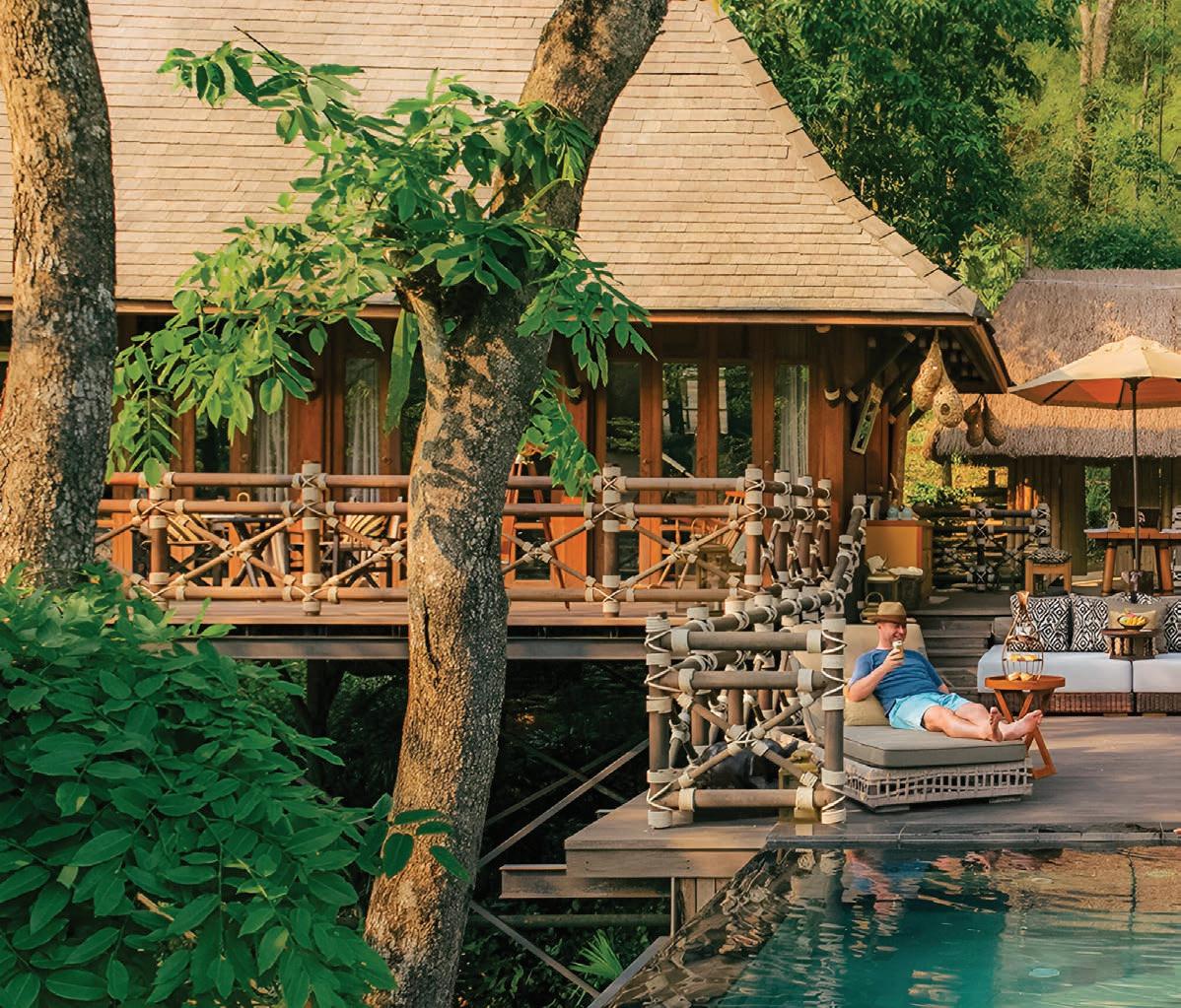
SUITE SENSATIONS
Properties around Asia go the extra mile and then even further courtesy of these exclusive residences

EXPLORER’S LODGE, FOUR SEASONS TENTED CAMP
Situated on a hillside at the confluence of the Ruak and Mekong Rivers, this two-bedroom villa offers a unique alternative to the resort’s 15 luxurious two-person tents, scattered throughout the jungle with sweeping vistas of Thailand, Myanmar, and Burma. Designed by Bill Bensley, the villa is inspired by the resort’s 19th-century safari-adventure theme, featuring meticulously crafted wooden furnishings, rich timber flooring, atmospheric hurricane lamps, and striking hand-hammered copper bathtubs. However, with its outdoor plunge pool and a wealth of activities centered around the camp’s rehabilitated elephants, it’s challenging to envision spending much time indoors. We recommend embarking on an invigorating ascent to the resort’s highest point for a breath-taking sunrise view behind the Laotian mountains during breakfast, followed by a soothing traditional Thai massage in the spa, enveloped by the lush bamboo jungle upon your return to camp.


PENINSULA SUITE, PENINSULA HONG KONG
This opulent pied-à-terre is a lavish sanctuary reserved for esteemed guests such as dignitaries, celebrities, and VIPs. It offers luxurious rooms and a private landscaped terrace that provides unrivaled panoramic views of Victoria Harbour and the cityscape beyond. The contemporary interiors of the suite are immaculately polished, featuring expansive floor-to-ceiling windows. Adorned with striking original artworks and a tasteful blend of modern and antique furnishings, the ambiance resembles that of a prestigious international art gallery. The suite boasts an array of expansive spaces, including a double height living area complete with a grand piano, a formal dining room with seating for ten, an adjoining kitchen, a private screening room, a well-equipped gym, and a sweeping master bedroom suite.
TATA SUITE, TAJ MUMBAI
The Tata Suite at the Taj Mahal Palace, Mumbai, stands as a testament to opulence and elegance. The suite commemorates Jamshedji Tata, the founder of Taj Hotels Resorts and Palaces. Created by the Malaysian design firm DesignWilkes, this suite exudes opulence, featuring crystal chandeliers, sumptuous tapestries, rare artwork, valuable antiques, and exquisite artifacts. Features include teak wood doors adorned with gold inlays that reveal two marble elephant sculptures. The grand living room’s dome has been meticulously refurbished with ornate gold stencil artwork, while the room itself showcases elegant ‘mother of pearl’ tables, silver-framed mirrors, and intricate Marquetry timber designs.


DALEM JIWO SUITE, AMANJIWO
Surrounded by picturesque rice paddies and graced with its exclusive entrance, the Dalem Jiwo Suite beckons with its two-bedroom pavilions, each adorned with grand king-sized beds supported by four majestic pillars. Spanning an impressive 12,917 square feet of living space, this suite boasts a generously sized Javanese stone swimming pool, a sweeping wraparound terrace, and two inviting outdoor bales for leisurely relaxation. The expansive outdoor areas provide enchanting vistas of the Borobudur Buddhist sanctuary, accentuated by a secluded outdoor bathtub that allows guests to fully immerse themselves in the tranquil surroundings. This haven of luxury is thoughtfully serviced by a dedicated personal butler and is perfect for families in search of spaciousness and exclusivity. Accessible through a private entrance and driveway, it offers a truly distinctive experience.
GRAND SUNSET RESIDENCE, ONE&ONLY REETHI RAH
The Maldives has more than its fair share of incredible residences. Arguably the most expansive and awe-inspiring of them all is the Grand Sunset Residence at One&Only Reethi Rah. The astonishing three-bedroom residence, which spans 22,808sqft, commands the largest private beachfront on the island, discreetly positioned at the end of a private road within a lush tropical landscape. It features remarkable indoor and outdoor living spaces, including dining and lounging areas. The first villa houses a king-sized master bedroom and a second bedroom with two queen-sized beds, Meanwhile, the adjacent villa boasts a spacious king-sized master bedroom, an opulent bathroom, and a breezy private terrace. Two swimming pools provide scope to cool off, and the soothing ocean is steps away.
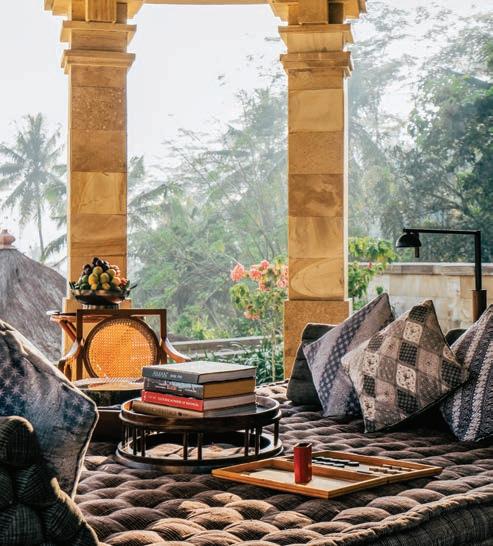


SENSE OF SANUK
Bangkok has established itself as one of the world’s fine-dining heavyweights while retaining the city’s trademark atmosphere of levity


It’s approaching sundown in Bangkok and the steamy tropical air is thick with a sense of hungry anticipation. The atmosphere in the city is always heady in the early evening. And as the last rays of light leak from the sky, bathing gold-spired temples in an ethereal glow, locals apply themselves to the day’s big event: dinnertime.
At street-side noodle stalls, the chatter of excitable conversation is only occasionally drowned out by the sound of loud, satisfied slurps. In traditional shop-house restaurants, gatherings of extended family avail themselves of giant platters piled high with fried rice and vegetable and terrines filled with spicy soups and fiery curries.
Elsewhere, culinary voyagers navigate choked streets to chow down at a growing contingent of world class restaurants where creativity and a commitment to sanuk – the Thai sense of fun – epitomize the freewheeling energy in Thailand’s charismatic capital.
Bangkok has always been a place where the spiritual is balanced by the earthly. The city is bejeweled with hundreds of temples from humble pagodas to grand complexes. Just as strong as any religious beliefs, however, is the Thai emphasis on sanuk, the idea that life should be enjoyable.



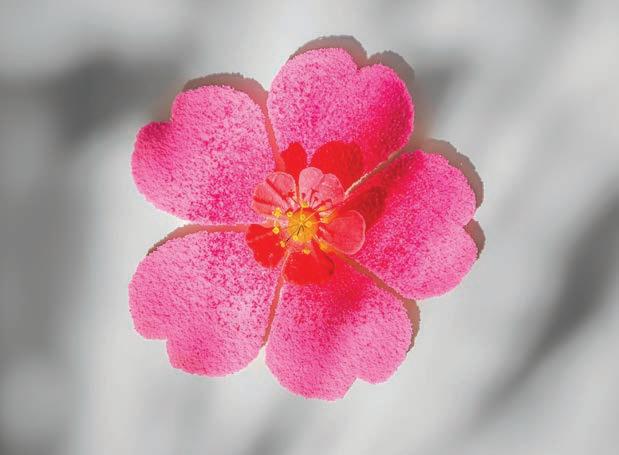
Although deadly serious when the occasion demands it, Thais tend to be very playful at work and in their day-to-day dealings. This unofficial national mantra resonates especially strongly when it comes to food.
Few places on earth are quite as abundant as Bangkok. Long a crossroads for trade and culture from other parts of the world, over the centuries the city has absorbed culinary influences from China, Japan, India, Europe and the Middle East as well as from Thailand’s diverse provinces.
Unsurprisingly, the modern metropolis is as delicious as ever. From pavement vendors serving up banquets for just a few dollars to bustling markets packed with produce and vibrant with color, the city has a knack for effortlessly whetting appetites.
Indeed, it’s easy to see why Thais have such a zest for eating and why chefs find the city such a stimulating place to hone their art.


This heightened sense of levity has seen the city emerge as one of Asia’s dining powerhouses. A host of boundary-pushers applying liberal portions of sanuk have taken the culinary scene on an ever-more thrilling tack.
Among these pioneers is Gaggan Anand, whose eponymous venue is a pilgrimage site for visiting foodies. Inspired by his apprenticeship at the three Michelin-starred El Bulli in Spain, Gaggan applies molecular gastronomy techniques to the cuisine of his native India.
The chef’s ebullient personality is reflected in creations such as his signature Dahli Chaat amuse bouche – an “exploding” yoghurt sphere with chutney and cumin – and a backward spin on a shami kebab where deep fried chickpea is rolled onto a chicken bone and served with apple and tamarind.
Of course, not every chef can be as adventurous (or as talented) as Gaggan. But there’s no doubt that his sense of daring and penchant for food play is emulated by other key players on the Bangkok dining scene.

Vietnam’s ascent as a regional gastronomic powerhouse took another step forward with the unveiling of the 2025 Michelin Guide.
Among the nine restaurants awarded one Michelin Star, two were new additions to the elite group, CieL and Coco Dining.
These newcomers joined a list of returning star-holders that includes familiar names such as Gia and Hibana by Koki in Hanoi, Anan Saigon and Akuna in Ho Chi Minh City, and La Maison 1888 in Da Nang.
VIETNAM STEPS UP TO THE PLATE

PLENTIFUL SEOUL FOOD
Seoul, unsurprisingly, is the nexus of Korea’s culinary scene. In the capital, its gastronomic manna reaches its apogee in numerous dining environments.
Restaurants such as Ryunique—where chef Tae Hwan Ryu references Japan, Spain, Italy, France, Australia, and Korea in his bold flavor concepts—and Jungsik, rated among Asia’s very best venues, embody the creative energy in Seoul’s culinary scene. Other notable names include Michelin-three-starred venues such as Gaon, La Yeon, and Mosu.
At Mosu, chef Sung Anh majors in “innovative contemporary food.” Take, for example, his signature abalone taco. It features fresh Korean abalone that’s been tenderized and massaged (instead of steamed), gently smoked for a subtle richness, and cradled in a crispy soybean shell.
Gaon is focused on delivering high-quality Korean cuisine that nurtures and follows the aesthetics of Korean traditions and culture.
Time-honored traditions of Korean cuisine are given a contemporary touch at La Yeon.




Over at Suhring, twins Mathias and Thomas Suhring have embraced Thailand’s national philosophy of fun at an acclaimed venture where childhood memories, prime ingredients, and German culinary tropes such as curing, smoking, and pickling are applied with an imaginative, contemporary touch.
“There’s zero local influence in our food,” says Mathias. “We don’t use lemongrass, Thai basil or fish sauce and chances are we never will – the German flavor palate doesn’t exactly demand it! What is very Thai is the ambience of the restaurant. We wanted to create a place where we can really get imaginative with our cooking and where people can go to unwind and have fun. Currently Bangkok is good for facilitating that kind of thing.”

Exuberant touches are evident throughout the dining experience at Suhring. Brotzeit, a course of fresh baked bread and pretzels with butter, dips and house-cured meats, gels with the Thai love of “family-style” sharing food, while a refined take on an oldschool Teutonic favorite offers a nod to Clements Wilmenrod, Germany’s first TV chef.
“When we were growing up in Berlin everybody knew Chef Clements,” explains Thomas as he describes Suhring’s version of Toast Hawaii, a Wilmenrod invention comprising a slice of toast with ham, cheese, pineapple, and maraschino cherry.
One might think that archaic creations borne of post-war scarcity in Central Europe would have no place in Bangkok – a resolutely forward-thinking mega-city. However, Wilmenrod is just another unusual ingredient in an eclectic stew of influences percolating in the city’s dining scene.
“It’s just a fantastic place in which to get creative,” says Riley Sanders, the creative visionary at the Michelin-starred Canvas. “There’s scope to relax and stretch yourself which you just don’t have in other cities where there’s much more pressure.”

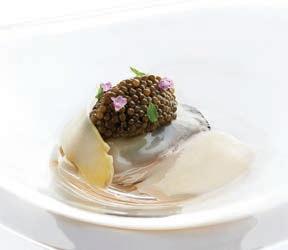
LION CITY CONTINUES TO ROAR
Singapore’s long-standing reputation for culinary excellence makes it one of the best places in the world for dining. The country covers every possible base from delicious local fare to some of the finest restaurants in Asia.
World-class restaurants are certainly not difficult to locate in the country. Among the starred restaurants in Singapore, there are several with three stars, including Odette, Les Amis, and Les Amis’ sister restaurant, Zen.
A fine-dining destination helmed by chef Julien Royer, Odette has been a regular feature in fine dining rankings since 2017. At Esora, Shigeru Koizumi stays firmly within the Japanese philosophy of eating seasonally, best enjoyed with one of the city’s few tea-pairing menus.
Michelin-starred Cantonese cuisine can be found at Summer Pavilion with elevated fare epitomized by dishes such as the poached rice with lobster, in a bisque-like soup.
Singapore is also rich in Peranakan (or Nonya) cuisine. A meeting of Chinese, Malay, Indian, and Eurasian styles, it is one of Asia’s most treasured food traditions. For an insight try Candlenut —the world’s first Michelin-starred Peranakan restaurant.
Hailing from Texas, but with experience at kitchens around the globe, Sanders puts his wandering ways to good use in a creative line up of dishes. Influences vary, but as he is grounded in Bangkok, there are strong Thai influences in items such as shrimp noodles dressed in intense seafood sauce and mud crab prepared with lotus root and stem, swamp algae and rice paddy herbs.
It’s not just international food in Bangkok that is benefiting from some realignment of the wheel. Thai chefs and venues too are playing with the tried and tested tenets of traditional fare to put a new spin on their country’s cuisine.
Among these is Thitid “Ton” Tassanakajohn, who is striking a blow for what he calls “progressive Thai cuisine” by combining modern techniques with bold Asian flavors at Le Du.
Born and raised in Bangkok, chef Ton talks fondly about his grandfather’s cooking. He also waxes lyrical about the city’s incredible street food scene, recommending the Udom Suk area where he grew up as a particularly febrile place to chow down al fresco.





TOKYO’S DELICIOUS TALES
Dining is one of the absolute highlights of visiting Japan. Indeed, eating anything less than oishi (delicious) is out of the ordinary.
As such, Tokyo immediately surpassed Paris with the most star ratings in the world upon its first Michelin rankings in 2008.
Legends on the Tokyo dining scene include Kagurazaka Ishikawa, known for its refined cuisine and all-round intimate dining experience – from the attentive staff who will help you find your way to the hidden alleyway location.
Other highlights include L’Effervescence known for its exquisite desserts, like caramelized apple and kuromoji ice cream served with muesli, plus its excellent list of French wines.
RyuGin, meanwhile, strikes a balance between time-honored Japanese cooking techniques and original dishes. It has earned three Michelin stars for a menu limited to a seasonal full-course degustation set.


Chef Ton’s passion for ripping up the rulebook has seen Le Du hailed as one of the most exciting restaurants in the city

He is a giant reclining-Buddha’s length from being a traditionalist however and his passion for ripping up the rulebook has seen Le Du hailed as one of the most exciting restaurants in the city. Although the chef insists the restaurant is Thai, a painstaking commitment to presentation intuitive approach to flavor combinations in creations like beef with pickled and raw Chinese cabbage and octopus with crab mayo and chorizo make Le Du difficult to categorize.

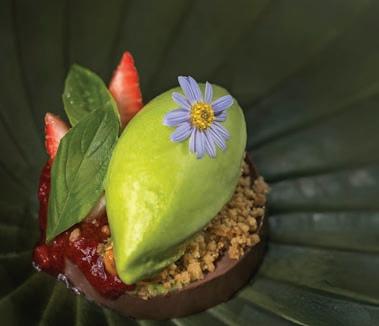
“I’m happy with that,” concurs the chef. “We don’t ever want to be considered obvious and we want to challenge our customers, while offering them something we are sure that they will appreciate. It helps that my training and experience has given me a good understanding of classic fine dining. I think that’s important. If I was messing around and just throwing a lot of flavors at the wall it would show.”
“Thai people can be resistant to change – especially when it comes to food,” he continues. “I’m as much of a fan of the traditional recipes as the next person, but as a chef it is my responsibility to take the cuisine forward. Whether that means sourcing the best quality produce locally and encouraging Thai farmers to up their game to compete at an international level or approaching local flavors and traditions in a creative way like at Le Du.”
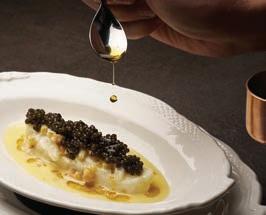

DESERT DELIGHTS IN DUBAI
Dubai’s already incredible dining scene has evolved thanks to the entrance of the Michelin Guide.
Dubai has two restaurants that have been awarded three Michelin stars: FZN by Björn Frantzén and Trèsind Studio.
Additionally, several other restaurants have earned one or two stars, including 11 Woodfire, Al Muntaha, Hakkasan, Höseki, Ossiano, Tasca by Jose Avillez, Avatara, Dinner by Heston Blumenthal, Moonrise, Smoked Room, La Dame de Pic Dubai, Orfali Brothers, and Manao
PARADISE FOUND
Asia’s oceans are scattered with jewel-like tropical islands that harbor some of the world’s most appealing accommodations
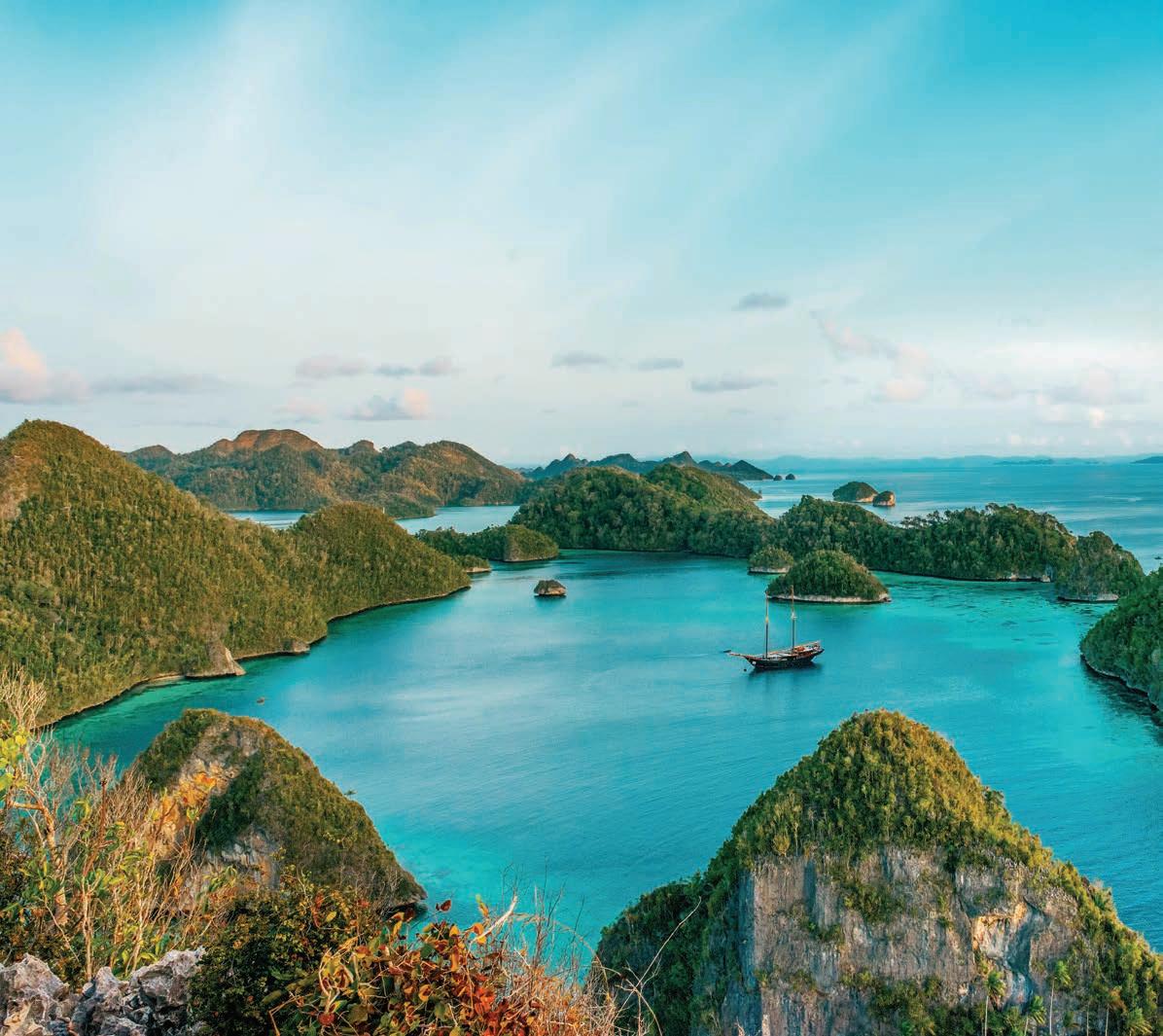
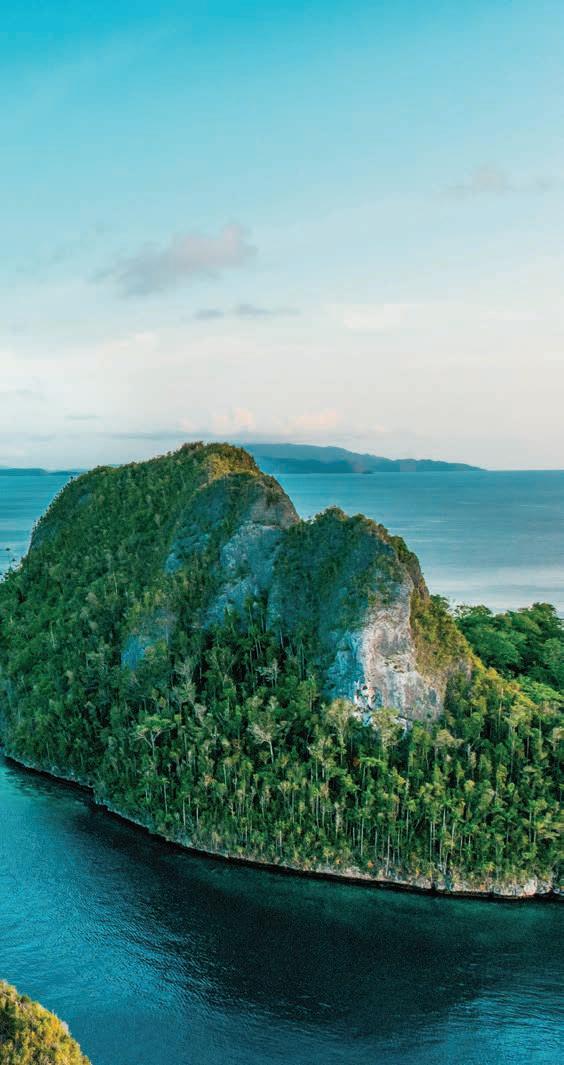
More fun in the Philippines
Comprising over 7000 tropical islands liberally scattered in the azure waters of the Pacific, the Philippines is one of Southeast Asia’s most individualistic and rewarding travel destinations. The country is — naturally — an island lover’s delight and is blessed with some of the world’s most exclusive retreats.
Located in North-eastern Palawan in the Sulu Sea, Banwa Private Island’s six hectares of lush, verdant landscaping and pristine white sand beaches provide a perfect environment for nature to thrive. It provides sanctuary for an incredibly rich and diverse number of flora and fauna species.
The island only has six villas, and these have been designed to immerse guests in the natural beauty of the island. Floor to ceiling windows bring the outside in, whilst the pool salas, beach and garden terraces create pure luxury of space. Infinity pools, meanwhile, appear to melt into the uninterrupted ocean views.
Adrift from Palawan, on its island in the Cuyo Archipelago, is Amanpulo, another of the country’s jewel-like retreats. Another treasured island is Siargao. Until recently, the island — just off the coast of Mindanao in the south of the country — was one of the best kept secrets in the Philippines. These days, it is much better known, but its castaway charm remains intact. It even has its requisite luxury components in the shape of resorts like Nay Palad Hideaway
Indonesia’s epic options
Straddling the equator from the Straits of Malacca in the west to Papua in the east, Indonesia is one of Asia’s wildest rides. And with the largest archipelago in the world encompassing just shy of 20,000 islands and islets, there’s no shortage of beach bliss to be discovered.
Sumba embodies Indonesia less explored. With its distinctive topography of rugged savannah and limestone hills planted with corn and cassava, it is visually unlike anything else in the nation. Adding to the mystery are hilltop villages clustered around megalithic tombs.
More familiar are the dazzling white sand beaches that encircle the island. Also, characteristic are the towering waves that have made the island a magnet for surfers. NIHI Sumba, a small, exclusive hideaway, is the perfect base to strike out to this coastal manna.
Singapore is a gateway for Bawah Reserve Indonesia, one of Asia’s most sumptuous private island resorts. In this secluded oasis, a petite and lush jungle is nestled amidst pristine white-sand shores, and all that surrounds you is the endless expanse of the ocean stretching toward the distant horizon.
It undeniably exudes the sensation of being in a remote paradise, precisely what you’ve been searching for. Even before stepping foot into your luxurious villa situated on one of the five enchanting islands that compose this resort—where, naturally, you’ve opted for one of the overwater suites—it becomes unmistakably evident that this is the ideal destination for unwinding, detaching from the world, and leaving behind the cares of home.


Maldivian magic
The Maldives has a simple and potent recipe for tourism success. Take arguably the best beaches on the planet, add scintillating options for diving and watersports, and complement these attributes by adding some of the world’s most sumptuous stays.
One of the superstars of the resort firmament in country is COMO Maalifushi , a property that is resolutely A-List. It’s a status reflected not only in a roll call of regular guests including famous fashion designers and Hollywood celebrities, but also in a setup that easily justifies the hype. Located in the northern Thaa Atoll and reached via a spectacular 60-minute seaplane flight from Male, the resort is seductively low-key with minimalist styling, knowing service, and stellar food and facilities.
While few would deny the appeal of the tropical-minimalist, barefoot-luxury template for Maldives resorts, it’s still a thrill when a property breaks the mold. Such is the case at Patina Maldives , Fari Islands, which differentiates itself courtesy of biophilic, Brazilian-Modernist design, lashings of ultra-contemporary design cool at its Studio MK27-conceived Beach Club, and a strong artistic bent. The latter aspect is showcased at its fullest via an art pavilion designed by James Turrell.
Another standout in The Maldives is the One & Only Reethi Rah. Sprawling across a private island — one of the biggest in The Maldives — the One&Only doesn’t lack for scale. And its grand ambition pays off, resulting in a resort that offers an all-encompassing experience that offers seclusion for those who want it, and a tantalizing array of choices for dining and activities.


...
Lush jungle is nestled amidst pristine white-sand shores, and all that surrounds you is the endless expanse of the ocean stretching toward the distant horizon
Khmer my love
Cambodia may be best known for its cultural wonders. But the string of islands that stud the Gulf of Thailand make it one of Asia’s top spots for beach-lovers.
Outposts such as Koh Russei, Koh Ta Kiev, Koh Rung and Koh Rung Samloem offer the kind of untouched island idyll whispered about by those seeking the epitome of Southeast Asian paradise. With long stretches of white-sand beach backing onto jungle clearings you could happily spend weeks swaying between coconut palms on a hammock.
Alternatively, if you are short on time, you could spend a couple of nights at Song Saa Occupying two diminutive islands at the far end of Koh Rung, the 27-villa development, which comes complete with trimmings like infinity pools, fully stocked bar fridges and a world-class restaurant, has picked up a string of awards. And it’s hard to fault the experts.
Even in its isolated setting, Song Saa offers a plethora of unforgettable encounters. These include morning snorkeling adventures in pursuit of seahorses, afternoon kayaking journeys through the mangroves alongside the resident marine biologist, and magical nighttime swims in waters that resemble something out of ‘Life of Pi’ with their bioluminescent glow.


SINGAPORE SUPS
Despite its diminutive size, the Lion City has emerged as Asia’s premier place to drink. We investigate the city’s surging cocktail scene to discover why
Although it’s hard to picture it now, there was a time not that long ago when finding a good drink in Singapore took some planning.
Beyond the famed Singapore Sling at the Raffles Hotel, there wasn’t much to speak of if you didn’t know where to look. In fact, local nightlife veteran Jerrold Khoo estimates there were only five or six craft cocktail bars in Singapore when he entered the industry about 10 years ago.
Today, “there are 30 or 40,” he wagers.
The Lion City doesn’t just have more cocktail bars, though. It has more great cocktail bars.
Unlike the spit-shined speakeasies and rooftop bars of decades past, now there’s a greater diversity of options than ever, “from high-end hotel bars to dive bars,” according to Khoo. That makes this an incredible time for fans of great drinks – and great bars – to be in Singapore.
For proof, look no further than Khoo and ex-Employees Only bartender Bai Jia Wei’s project, Stay Gold Flamingo.

BANGKOK
Charoenkrung Road, Bangkok’s oldest paved road, is one of the fulcrums of Bangkok’s cocktail scene. The evolution has been alchemic for lovers of great drinks served amid convivial surroundings. At Four Seasons Bangkok, BKK Social Club is one of the city’s finest bars. Mixologist Philip Bischoff looks after the drinks here, and his creations — inspired by the glamour and lifestyle of Buenos Aires — are befitting of acclaim. Next door at Capella Bangkok, Stella features throne-like chairs, hand-painted frescoes, and a taxidermized white peacock that takes center stage under a mirrored ceiling.
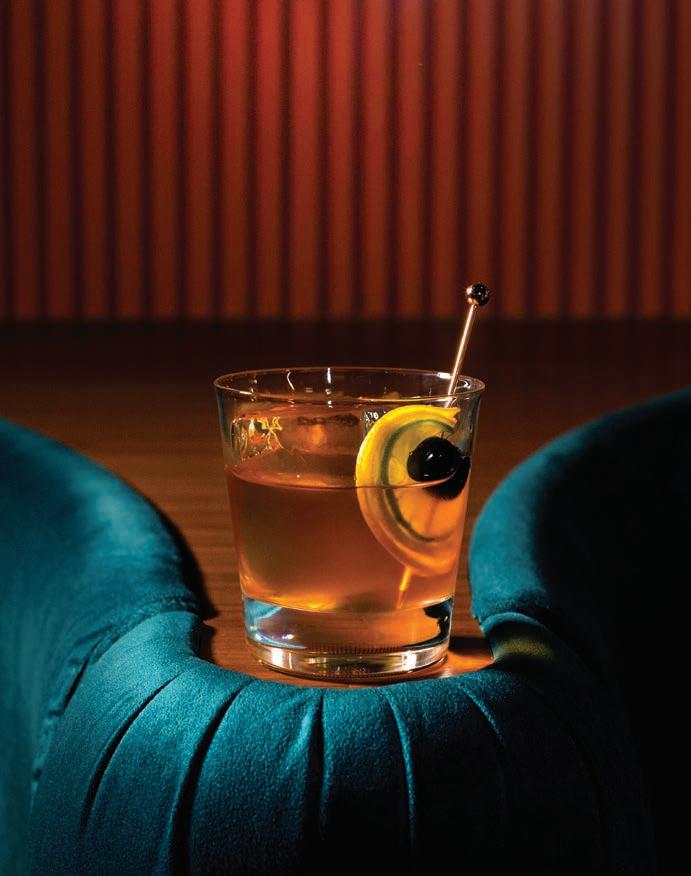
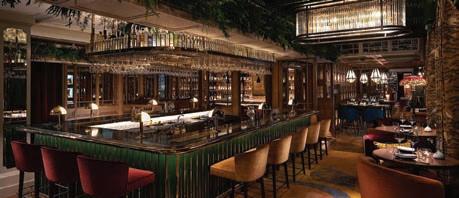
HONG KONG
Hong Kong boasts a vibrant bar scene. Coa, renowned for its artisanal mezcal and innovative cocktails, is ranked as one of Asia’s best bars. Meanwhile, Argo is a hidden speakeasy, known for its intimate ambiance and expertly crafted drinks. Darkside exudes old-world charm with its colonial-inspired décor and a wide selection of rare spirits. The Aubrey, nestled in the Mandarin Oriental, combines Japanese flavors with an elegant rooftop setting. Penicillin is a must-visit for whisky enthusiasts, featuring an extensive collection of Scotch, while Quinary excels in molecular mixology, pushing the boundaries of cocktail creativity.
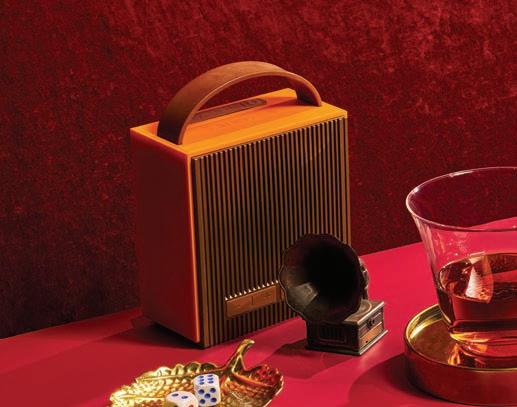
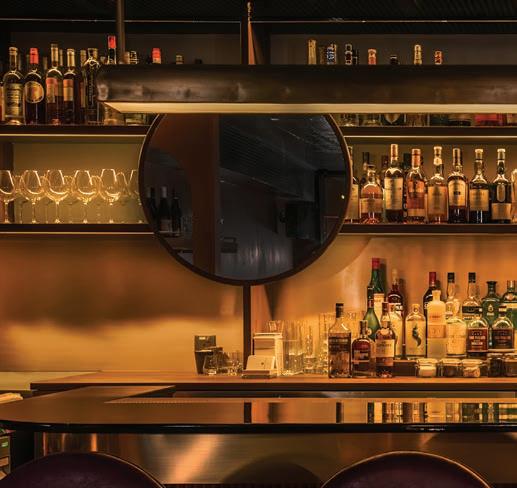
Located on Amoy Street, in Chinatown, the bar isn’t your usual jazz joint for suited and booted execs or local celebs. It’s a place where “you can put on rock and roll music and have a Manhattan,” says Khoo, an alum of Jigger & Pony and former rock star himself. “We fused together elements of the street with the posh ideals of a cocktail bar.”
Staff patrol the floor in paint-splattered suit jackets that recall the work of Jackson Pollock, while the soundtrack likely will feature more Arctic Monkeys than Duke Ellington.
But Stay Gold Flamingo is more than rock and roll. It’s multiple venues, each offering something unique that seeks to cater to locals rather than award show judges.
In the front of the building, the vermillion-hued Flamingo operates as a café by day, serving Asian fusion dishes and coffee made from locally roasted arabica beans. The space transforms into a wine bar at night, where Khoo and Bai serve “the underdogs” of the wine world. (Natural wines and lesser-known producers from Spain and Argentina, for example.)


In the back, there’s Stay Gold, where Khoo and Bai “let [their] bartenders run wild” to create 16 signature drinks that speak to the venue’s Jekyll and Hyde identity.
There’s a mix of low-alcohol and stiff expressions inspired by Singapore’s flavors, ingredients and cultures. Think espresso martinis made with toasted coconut meringue to pay homage to Singapore’s cafés, a sugarcane-inspired milk punch that speaks to its hawker culture and the Gentleman’s Club, a smoky, bourbon-based drink with patchouli and lapsang souchong tea that honors the city’s once-notorious entertainment.
Wider recognition validates Khoo and Bai’s creative choices, as well as their ability to appeal predominantly to a local crowd pining for a more casual drinking experience.
Perhaps the clearest example of the sea change occurring in Singapore’s nightlife, however, is the emergence of independent venues like Sago House.


The bar is owned and operated solely by industry veterans Desiree Jane Silva, Jay Gray and Abhishek C. George. The three opened Sago House during the pandemic without outside financing. No investors, no banks – a rarity in one of the world’s most expensive cities.
“It’s our blood, sweat and tears on every inch of the bar,” says Silva, whose 12-year career began at 28 HongKong Street. “Everything was intentional and very personalized.”
This proud individualism has given Sago House a character few other venues can achieve.
Hidden on the third floor of a building on Sago Street in Chinatown, the bar greets you with a colorful mural produced by Filipino artist Distort Monsters and a neon sign behind the bar bearing the words “don’t try” – author Charles Bukowski’s famous credo for success in art.



SEOUL
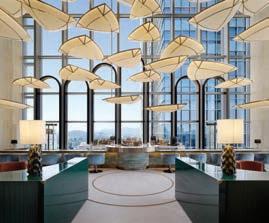
Seoul’s vibrant and innovative bar scene is embodied by Zest which pursues a zero-waste philosophy in its array of meticulously crafted cocktails. Alice transports patrons to a whimsical wonderland with its Alice in Wonderland-themed décor and imaginative drinks, making it a surreal escape. Pine and Co, located in the trendy Itaewon district, is a chic speakeasy known for its craft cocktails and cozy atmosphere, perfect for intimate gatherings. 1914 Lounge and Bar, situated in the Josun Palace, celebrates the city’s history with a vintage ambiance and signature cocktails inspired by the early 20th century.

The other accents and interiors, meanwhile, feature an edgy, street-wise look brought to life almost exclusively with self-made or upcycled materials.
“We love art and hip hop, so that was the basis and part of our brand,” says Silva. “We also kind of wanted to prove to the world that you don’t need a million-dollar build to have a great bar.”
Touches like these have rather quickly transformed Singapore from a place to get a great drink into Asia’s best place to drink. Industry peers have noticed the evolution, too.
“What I love about drinking in Singapore right now boils down to two main points: the ease of traveling between bars and the sheer variety and quality of drinks and experiences you can get,” says Chuan Poh, co-founder of the up-and-coming Night Hawk.
“With such a melting pot of ideologies, perspectives and experiences, we end up having bars that are unique from each other offering a plethora of options, whether mild or wild.”
His bar represents that diversity better than most.
Night Hawk deals in retro-futurism: the point where past, present and future meet. Marked by a hawk insignia on a door off Tanjong Pagar street, the speakeasy on the inside is windowless and bathed in a familiar warm, reddish light. Named after artist Edward Hopper’s mid-century painting of the same name, it at once recalls 1950s America and a watering hole in a sci-fi movie set centuries after ours.
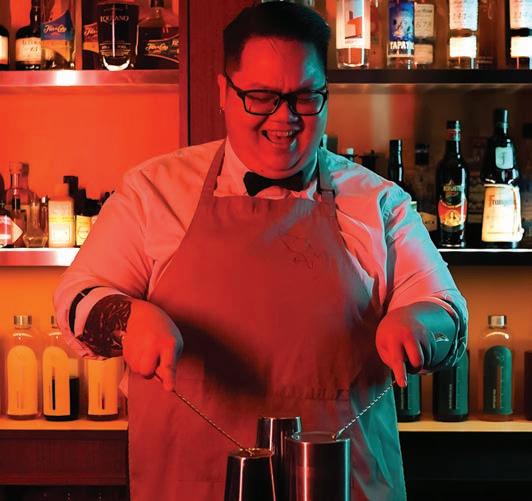

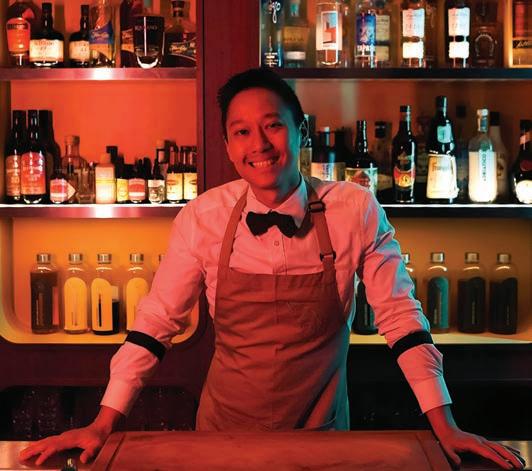
For founders Poh and Peter Chua, this was a very intentional aesthetic.
“Singapore has been so focused on raising the bar that we’ve missed one of the fundamental uses of a bar: escapism. People here don’t only drink to have fun, but also to temporarily escape from the hustle and bustle of the city,” says Chua.
“Like tiki bars in the late ’60s, Night Hawk was designed to not look like any specific space or era to facilitate the idea of escapism and also tackle the paradox of time.”
What Chua means is the venue pulls you away from reality by blending trends that are both real (from the past and present) and imagined (what Chua and Poh believe will shape cocktail culture in the future). That philosophy largely manifests as fusion.
Space Age-named drinks like Gamma-ray Holiday offer modern twists on classics – in this case, they give the Midori sour a local spin with bitter gourd. The signature cocktail Nighthawks, meanwhile, is a can’t-miss riff on Irish Coffee: rum-infused coffee, vodka and amaro are shaken together and layered with coconut and palm sugar foam.
Drinks like these don’t only capture Singapore in a glass. They also speak to the pride and joy the city’s bartenders are feeling as they continue to elevate the drinking experience for themselves and their customers rather than seek awards or maximize returns.
As Khoo says, “The real judge will always be the customer sitting in front of you.”

TOKYO
Tokyo’s cocktail bar scene is a dazzling fusion of tradition and modernity. Bar Benfiddich, helmed by the skilled Hiroyasu Kayama, infuses Japanese craftsmanship into its cocktails, often using herbs and botanicals from his garden to create unique flavors. SG Club, located in the upscale Ginza district, offers a sophisticated experience with a focus on rare and vintage spirits, making it a haven for whisky connoisseurs. Virtu, on the other hand, embraces modern mixology techniques, pushing boundaries with its avant-garde cocktails and artistic presentation.
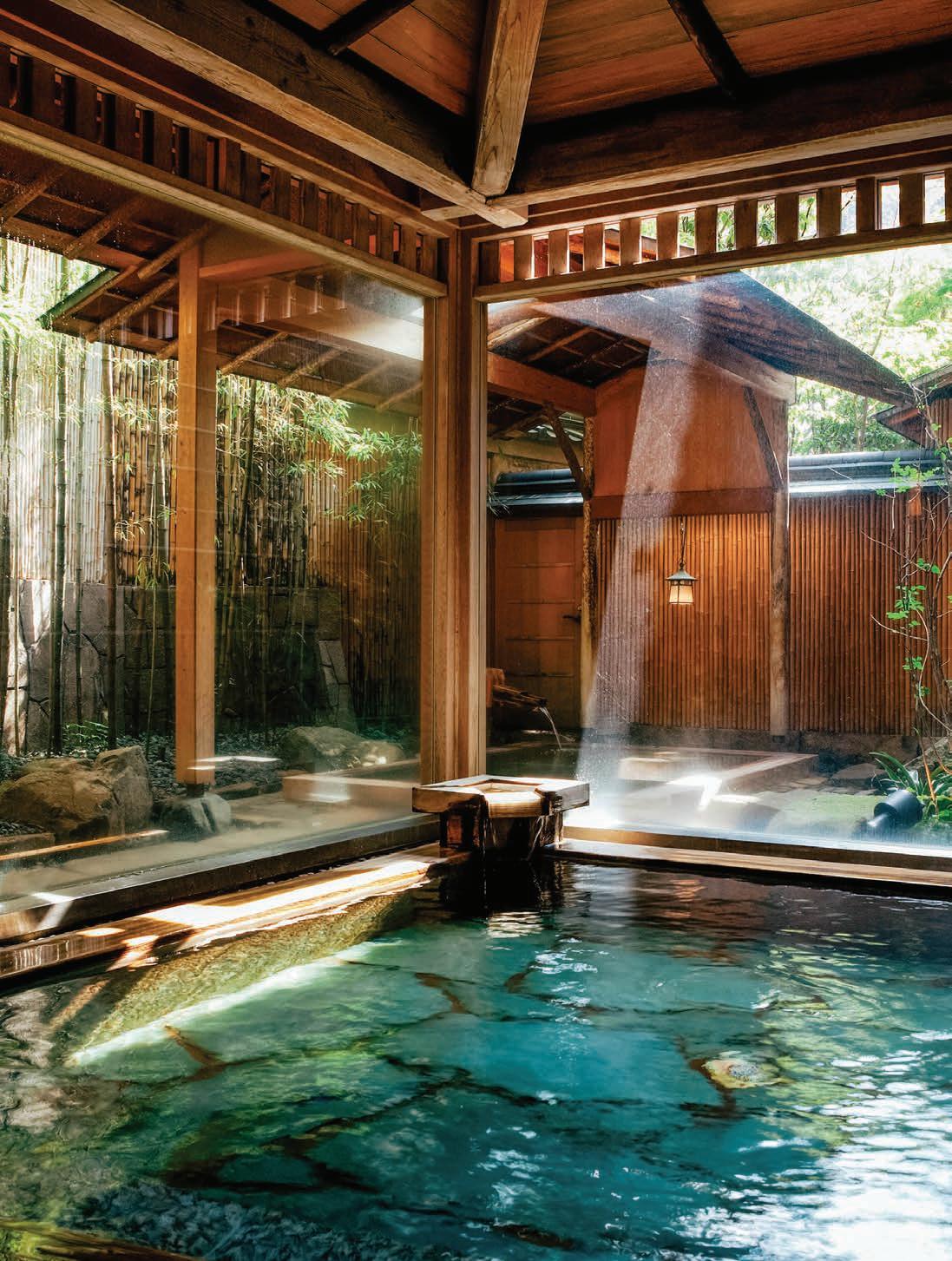
READY TO RELAX?
With impeccable accommodations enhanced by kaiseki dinners and onsen bathing, ryokans represent the pinnacle of Japanese hospitality



Originating in the 17th Century, during Edo period Japan, ryokans are inns that traditionally served travelers such as nomadic samurai and traders along the country’s highways.
Many such establishments still serve such a functional purpose today. Others, however, are much more opulent and a stay in one is a major highlight of many Japan itineraries.
Despite some common features, many of the best ryokans distinguish themselves with design or service quirks, opulence of bathing facilities and by the sheer quality of their food.
With stunning ryokan scattered the length and breadth of Japan it can be difficult to narrow down the selection. Here are some of our picks to help you down the right road.
RYOKAN KURASHIKI, KURASHIKI
Overlooking the Nakabashi Bridge at the center of the Bikan Historical Quarter, by the banks of a pretty, willow-lined canal, sits this beautiful ryokan. Situated at the center of the waterways and streets of the city of Kurashiki’s lovingly preserved Bikan quarter, Ryokan Kurashiki is an oasis of elegant calm in the bustling, history-steeped district.
“This is a wonderful ryokan with excellent kaiseki dinners, located right on the charming canal in an adorable little town with narrow windy streets lined with shops and cafes,” says Catherine Heald, co-founder and CEO of Remote Lands. “It pairs well with Naoshima since it’s not too far away (or on the way).”
ZABORIN RYOKAN, HANAZONO
Zaborin embodies the essence of a luxurious hotel experience in perfect harmony with Japan’s renowned subtlety and grace. While it doesn’t overwhelm you with extravagance, it quietly provides everything you could ever desire. This exclusive retreat boasts only 15 villas, each featuring both indoor and outdoor onsen baths filled with the purest volcanic water. Nestled amidst tranquil meadows and pristine forests, Zaborin offers an intimate and secluded ambiance, while granting you easy access to some of Asia’s premier ski slopes right at your doorstep.
“We love the design of the overall ryokan and the rooms themselves, each of which has a private indoor and outdoor onsen,” comments Catherine Heald.
BENIYA MUKAYU, YAMASHIRO ONSEN
Nestled atop a hill with commanding views of Yamashiro Onsen town in Ishikawa Prefecture, Beniya Mukayu offers a harmonious blend of warm, attentive service and a profound connection with the tranquillity of nature.
The ryokan now stands where a renowned Zen Buddhist temple once thrived, drawing inspiration from the temple’s pure and simple aesthetic to cultivate an atmosphere of serenity and harmony with nature.
This hybrid ryokan has rooms with both tatami mats for guests to sleep on futons as well as thick mattresses on platforms for those who prefer beds. Delicious kaiseki dinners and Japanese breakfasts are a highlight.
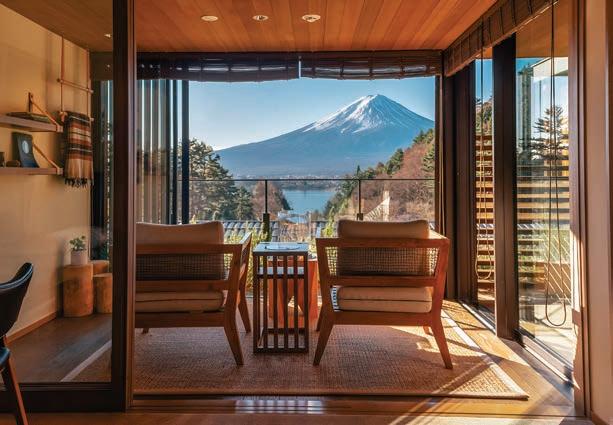


FUFU KAWAGUCHIKO, LAKE KAWAGUCHIKO
Fufu Kawaguchiko seamlessly combines the unmatched personalized service of a traditional Japanese ryokan with the cozy ambiance of a forest lodge, creating an ideal retreat for guests looking to immerse themselves in the breath-taking natural splendor of Yamanashi.
The establishment skillfully blurs the boundaries between indoor and outdoor spaces.
Its collection of 32 thoughtfully appointed suites offers guests not only stunning vistas of Mount Fuji mirrored in the glistening waters of Lake Kawaguchiko but also the luxury of a private open-air hot spring bath.
Additionally, the floor-to-ceiling glass doors in each suite can be fully retracted, effortlessly transforming the entire room into an expansive open-air veranda, allowing you to fully embrace the surrounding beauty.
NISHIMURAYA HONKAN, TOYOOKA
Kinosaki Onsen is one of Japan’s most charming onsen towns. And this is one of its best traditional ryokans. It offers 34 guest rooms, all designed in the traditional Japanese style. Guests at this establishment can indulge in the relaxation of three private hot spring baths and also enjoy complimentary access to all seven public hot springs in the charming Kinosaki Onsen town. Additionally, guests have the option of savoring traditional kaiseki dinners through inroom dining services.
“Kinosaki Onsen is a fabulous destination,” comments Catherine Heald. “Guests can sample every onsen, each of which is different with varying temperatures, mineral content and design.”
TAILOR-MADE EXPERIENCE
LUXURY ADVENTURES IN ASIA
SMALL ELEGANT PERSONAL AND SOCIAL SPACES
ULTIMATE LUXURY AND COMFORT

INDONESIA AQUA BLU
15 cabins l 30 passengers

WORLD-CLASS DINING
CAMBODIA & VIETNAM AQUA MEKONG

20 cabins l 40 passengers

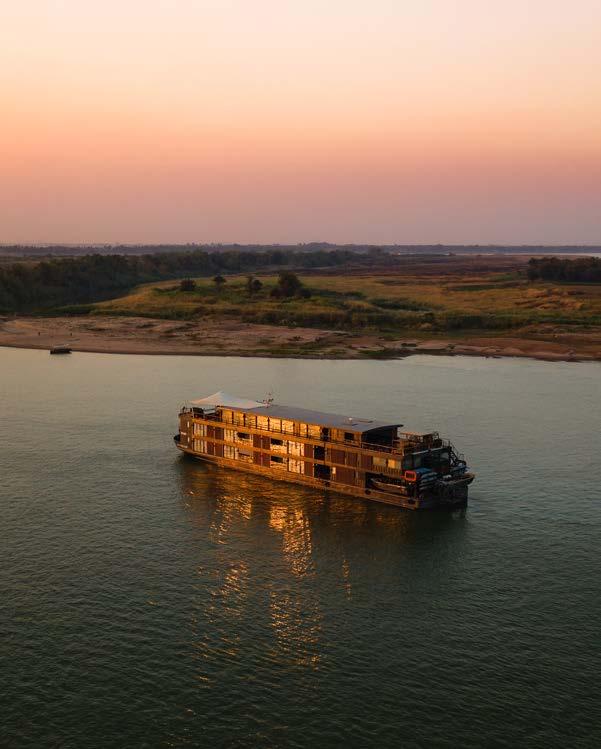
RESPONSIBLE TRAVEL




ASIA
Experienced storytellers for discerning travelers.
For daily articles from journalists, photographers, and adventurers exploring 38 countries in Asia, visit our online magazine at RemoteLands.com/Travelogues.



